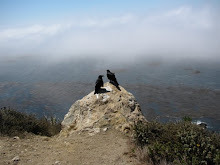Danny was invited to see their larger sanctuary, located in the city of Gurgaon, which is an hour's drive to the south of Delhi. Technically, we were tagging along with a French filmmaker and her French informant, who were making a piece on dogs and animal welfare in India. Friendicoes provided transportation, which turned out to be an animal ambulance. Along one side of the van was a medical stretcher, with a small padded seat opposite. I sat in the back with the two French women, where it was so cramped that my knees pressed up against the metal bars of the stretcher. It was clear that the vehicle served animals, for as the sun heated up the ambulance, there was a faint but distinct smell of dog.
After a long and bumpy ride, we arrived at the sanctuary. Upon climbing out of the ambulance, we were greeted by the enthusiastic barking of hundreds of dogs. On either side of a narrow walkway were two fenced-in enclosures, with more dogs than I've ever seen in my entire life. Some had collars. Some had injuries or skin diseases which were being treated with an orange ointment. Some were sleeping in the heat of the late morning. The vast majority of them, though, were barking, following us as we walked along the path, and jumping up on the fence to greet us. There were even some up on the roofs of the buildings inside the enclosures, barking at us from on high.
Friendicoes has a no-kill policy, so once an animal ends up in their shelter, they are there for life, unless they get adopted. There are so many dogs at the sanctuary, in fact, that it seems they have run out of room in the dog section and are housing many more in the wildlife section. Despite the huge number of dogs housed there, it's actually quite roomy, with plenty of space for the dogs to move around, as well as spaces for them to get privacy if they need it.
Danny and I walked to the wildlife section, at the rear of the complex, where the macaques were kept. It's also where they keep langurs, guinea pigs, rabbits, geese, pigeons, kites, vultures, parrots, chickens, rats, and another hundred dogs. All the various animals are kept in cages, except for the dogs – in this area, they are kept in the open space between the cages. So when Danny and I first went in, we were surrounded by barking, tail-wagging dogs. The only way most of them knew how to interact with humans was to jump up and put their paws on us. After just a couple minutes, I was covered in dusty paw prints. The staff quickly put leashes on the rowdier dogs and tied them to the fence or to trees.
We toured the facility and looked at all the animals. A lot of the macaques housed here had been injured at some point and were now permanent residents at Friendicoes. In one cage were two monkeys: one had lost an arm, while the other had lost his hands. Some other macaques had once been monkey dancers, which is an illegal form of entertainment in India. These were missing their front, sharp teeth, which had been pulled out by their previous owners so that they couldn't inflict damage if they tried to bite.
I wish I could have taken a dog (or several) home with me. They were all so sweet and just wanted to be loved up. Since I can't adopt an Indian dog, I'm glad these guys at least have a nice place to live where there are people who care about them. Having visited Friendicoes, I plan to add them to the list of organizations that I donate to, which already includes an animal welfare group: the Marine Mammal Center. I also plan to get back involved with volunteering at the local animal shelter at home.
If you're interested in giving to Friendicoes, there is information on their website. Every little bit helps, especially in India where a dollar goes a long way, and you could make a dog – or a monkey – very happy.







Thank You SO much for writing about them.
ReplyDeleteI plan on a donating a nice chunk for Christmas~ oh..we live close to one another!
Very close :0)
Hi,
ReplyDeletewe have our own blog now - www.friendicoes.blogspot.com
Remember meeting Danny at the shelter, too.